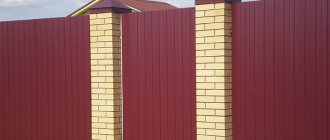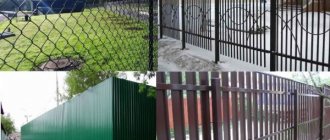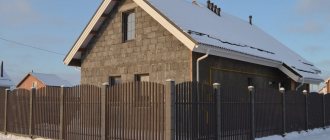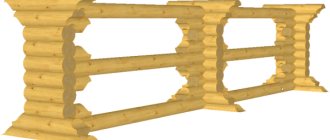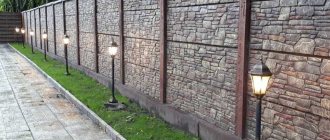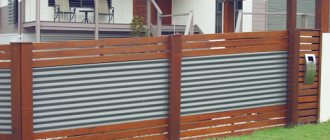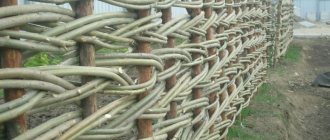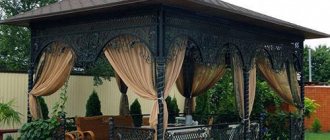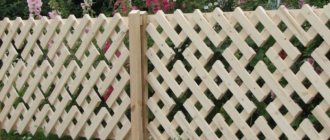What fence posts are needed and their functions?
The fence on the site is usually built for many years. Therefore, its construction should be treated with no less scrupulousness than the construction of the house itself. A fence is a technological structure consisting of a foundation, support pillars and filling sections. When planning construction, every owner must understand that it is the supports that bear the main load. The fence posts installed must be stable and provide the entire structure with the required rigidity and durability. Installation of fence posts has functional features:
- ensuring resistance to loads. The higher the fence is planned, the stronger the supports should be;
- installation in compliance with the provided technologies;
- The important point is how deep the builders will bury the fence posts and the method of embedding them. These factors are important for maintaining the verticality of the entire fence;
- selection of material for fence posts. It can be harmoniously combined with the filling, or it can be in contrast with it, creating a special design effect;
- choosing the type of posts that corresponds to the filling of the fence, taking into account its weight.
Types of fence supports
The difficulty of installing the posts depends on the material from which the fence sections are made. If you need to install pillars under a fence made of corrugated sheets or chain-link mesh, then huge brick pillars will look ridiculous, and if you mount a fence made of concrete sections on metal posts, then no one will give you guarantees on the strength of this structure.
Experts distinguish the following classification of fence supports:
- brick - used for installation of brick, metal or wooden fences;
- wooden - for a picket fence or chain-link fencing;
- metal – for fence sections made of corrugated sheets, mesh or metal;
- asbestos-cement pipes - for mesh or metal fence;
- concrete - for a fence made of concrete sections.
Types of fence posts
The variety of materials makes it possible to build a fence on the site with your own hands that will be in perfect harmony with the entire territory and architecture of the buildings on the site. The choice of material for the fence depends on the financial capabilities of the owners and their tastes. Now manufacturers offer ready-made options for fence supports, made in compliance with all technologies.
Wooden
Wood is considered a traditional material among the population. Wooden supports today are quite expensive, although solid hardwood logs, even with the necessary processing, will last no more than three years. Wood is unstable to changes in temperature and humidity, and is susceptible to rot and mold. The most resistant to these factors are larch, oak, pine and some other species. Birch, maple, fir, and beech are considered unsuitable for making poles. To increase their service life, special antiseptic treatment is required. Therefore, wood is more often used to build low fences for front gardens and temporary barriers.
The solution to the question of how to install the posts evenly lies in the method of drilling holes. When deepening, the drill should be kept in a strictly vertical position. Each column is checked for verticality with a level.
Installing wooden fence posts in metal cylinder sleeves will increase their service life, and these devices are quite easy to make with your own hands. The sleeve should have a smaller diameter than the girth of the post, fit tightly and prevent moisture from entering the tree. Often the choice of such material is determined by the existing style of the site. The filling of fencing sections is often also made of wood.
Concrete
Fence posts made of concrete are distinguished by their low price and high technological qualities. The material is resistant to mechanical stress, does not rot and does not require constant maintenance. Concrete is reliable and has high strength characteristics, thanks to which it serves its owners for many years without losing its original appearance. The building materials market offers many ready-made forms made of plastic, metal and other materials into which concrete can be poured and finished products obtained. You can create a mold yourself by making a matrix, with the help of which several products are made at once. For this you need:
- boards 3×25×250 cm (9 pieces);
- boards 3×25×100 cm (2 pieces);
- screws, screwdriver, sheets of tin, metal plates (8 pieces), fittings, concrete mixture, oil.
Boards (6 pieces) 250 cm long and boards 100 cm long are covered with tin on one side, and the remaining three (dividing) are covered on both sides. Formwork is assembled from them using screws. Before laying the concrete mixture, the formwork is lubricated with waste oil. The reinforcement is being prepared and laid. Concrete is poured into the resulting structure, which should be carefully leveled. The workpiece is covered with burlap and must be wetted for a week. After the concrete is ready, the formwork can be easily disassembled. The forms are ready.
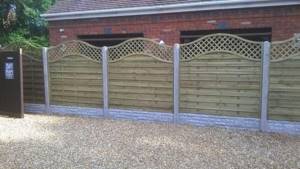
There is a simpler technology for making concrete supports - using plastic pipes. For this, a well with a depth of at least 1.2 m is prepared. A pipe with dimensions corresponding to the required dimensions of the column is selected. It should be buried, installed strictly vertically. Wire formwork is placed inside the pipe and concrete is poured. After a week, the pipe can be carefully removed, the support is ready. Concrete posts are usually used for fences with heavy, bulky filling.
Asbestos pipes
If the fence builder does not aim to create a structure of increased strength and durability, the use of asbestos-cement pipes is appropriate. They are suitable for light fences: made of wood, profiled sheet or mesh. If installed correctly, such supports can be used for a long time, since the material is not subject to corrosion and rotting. Installation considerations:
- correctly calculated depth of holes for supports;
- high-quality concrete filling;
- connecting pipes using special couplings.
Cuttings of asbestos pipes are attached to each other using couplings (polyethylene or asbestos). When connecting the coupling to the workpiece, a gap remains, allowing the pipe to deviate at an acceptable angle. By connecting pipe cuttings with couplings, you can get a finished support. The disadvantages of asbestos-cement racks include:
- fragility. The material splits when hit or dropped;
- pipes that are not filled with concrete may collapse if water gets inside. Water frozen inside the pipe will simply tear the workpiece;
- ugly view.
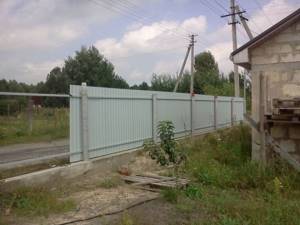
Before installing asbestos poles, pipes (thickness - 9 mm, length - 3950 mm, diameter - 118 mm) are cut into blanks, focusing on the height of the future fence. An ordinary drill is used to prepare the holes. By choosing their depth, the type of soil and the length of the spans are determined. For a pole made of asbestos pipes, a depth of 0.8 m will be sufficient.
Brick pillars
Laying brick pillars is quite accessible even to a person far from construction. Prefabricated combined fences made of brick posts and corrugated sheet or wood filling will cost the owners much less than a fence made of solid brickwork.
When choosing the type of foundation for a brick, the material from which the fence itself will be built is taken into account. If it is supposed to be light, you can use a pile foundation for each support, taking into account the type of soil and the proximity of groundwater. If the fence is being built on heaving soils, holes should be drilled 20 cm below their freezing level. On light and well-drained soils, a depth of 0.8 m will be sufficient.
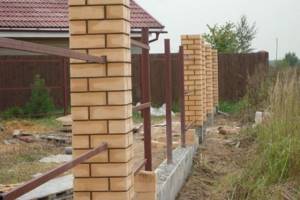
Crushed stone is poured into the prepared hole, a pipe is placed around which the pillar will be laid. For difficult soils, several reinforcing bars are inserted into the hole and concrete is poured. Bricks are placed around the pipe, installed strictly vertically. Each row is clearly checked with a level and rods.
Metal fence posts
Metal pillars are a structural element that bears the weight of the entire load on the structure. The iron supports hold the logs attached to them, onto which the fence filling is attached. Pipe posts can be used in the construction of fences made of wood, corrugated sheets, mesh, and picket fences. Metal supports have a number of undeniable advantages over other types of poles:
- high strength indicators;
- resistance to loads;
- ease of use;
- simple installation;
- long service life;
- affordable price.
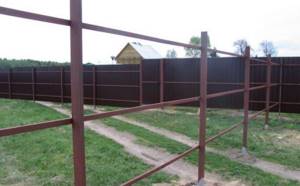
To install metal supports, two types of pipes are used: profile and round. A round blank is cheaper than a profile blank, but is not very convenient for installation. Such products are used for simple and inexpensive fencing. The profile blank is stronger and easier to work with during installation. The optimal dimensions to ensure structural strength are: diameter - 6 mm, wall thickness - from 2 mm. Installation, strengthening of metal fence posts and installation of horizontal logs to them are simple and will not take much time.
Which posts to choose for a fence?
The wise owner at all times tried to secure his home by any means. And the installation of a fence is proof of this. Today, the construction market is replete with all sorts of options for high-quality and aesthetically attractive materials for the construction of unique fencing. Everyone can choose the type, height, color and length of sections. But it is always important to remember that correctly selected posts are the foundation of a durable and reliable fence.
There are many types of posts that serve as support for the future fence. As a rule, the choice depends not only on the quality of the material and stylistic relevance, but also on the cost. The price range of materials is quite wide, so everyone can choose the appropriate option. Another point that is worth paying attention to when choosing a pole material is the installation method.
To ensure long-term operation of the future fence, it is important to ensure that the post is resistant to natural and mechanical influences.
Today you can choose completely different options for pillars: wooden, asbestos-cement, reinforced concrete, metal, brick.
Wooden posts can support fences made of different materials. The main condition for such pillars is high-quality and dry wood, with a minimum amount of damage. The advantage of wooden poles is their low price, environmental friendliness and ease of installation. However, these pillars are characterized by low resistance to weather changes, so they must be constantly tinted.
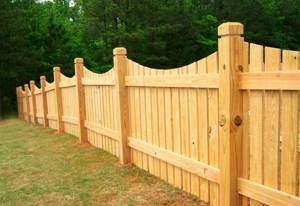
Steel poles made from round pipe are more practical and durable. They are great for installing chain link fencing. Steel posts do not require special maintenance and are easy to attach infill to. The price of poles of this type depends on the coating, size and auxiliary elements.

fence posts However, it is difficult to attach spans to them, so it is necessary to use special clamps and clamps. Also, in asbestos-cement pillars, it is necessary to close the upper hole of the pipe, where rainwater usually penetrates and freezes.
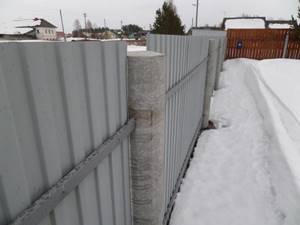
Concrete pillars are the most common option. The main advantages of concrete pillars are weather resistance, versatility and durability. However, this option has a fairly high price and requires a foundation. If you make concrete pillars yourself, you will have to try. After all, in addition to the fact that you need to make a solution, you need to build the formwork and wait until the solution hardens.
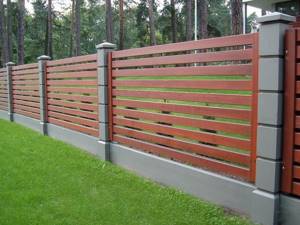
And finally, brick pillars . It should be noted that the fence does not have to be continuous. Support pillars can be made of brick, which is the most durable material. Brick pillars go well with fences of different types and materials. You can easily vary the size of the future fence, which will allow you to realize the most unusual design solutions. Visually, brick pillars look lighter and more elegant, which makes it possible for them to fit into any interior. When erecting brick pillars, you can choose the required color and texture to combine with the design of the fence. You can also use decorative bricks, which will undoubtedly perfectly decorate the area.
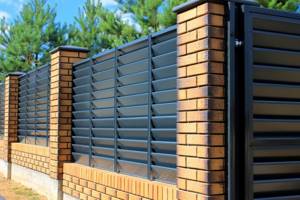
Choose a beautiful combination of brick and high-quality fence spans that will delight the eye for many years. You will receive not only reliable protection, but also a stylistically attractive design.
At what distance are the pillars installed?
One of the most important stages in fencing an area is marking the site where the fence will be built. Proper marking will allow you not to overpay for extra purchased materials and tools. You can calculate the length of the fence span by measuring the full length of the fence, using pegs around the perimeter and stretching the twine between them. The standard distance between supports is considered to be 2.5-3 m. If a distance exceeding these parameters is adopted, the section web will not withstand wind loads well and may fall. If the distance taken to install the fence is less than the norm, then the fence will have increased strength and stability, but the owners will have to spend money on purchasing additional materials, which will greatly increase the cost of the fence.
Wooden supports

Wooden pillars, although they cannot boast of such durability as concrete products, still continue to be in demand in construction. They are used as load-bearing supports for fences, they are used to make columnar foundations and decorate terraces. Below we will take a look at how wooden poles are installed.
It is important to understand that the pillars will be dug into the ground, so the wood will be affected by dampness and temperature changes. Given these conditions, there is no need to use soft types of wood for arranging pillars. The optimal species is larch or pine - they have a dense structure, as well as resistance to rot and insects. And when they dry, the shape of these pillars will remain the same, which cannot be said about products made from birch, aspen or maple.
Before installing wooden poles, they must be carefully prepared - cleaned of bark and treated with special means that protect them from negative influences. If the poles were already sold without bark, then the surface of the material should still be sanded with sandpaper to get rid of small irregularities.
As for installing a wooden pole, you will need to make markings, dig holes and place the poles in a vertical position, and then compact them.
To carry out the work you will have to use:
- Drill or shovel;
- Tape measure and level;
- spacer;
- A crowbar for tamping.
You will also need crushed stone and concrete mortar.
Pegs, tape measure and cord will be needed to mark the places for the posts. First of all, the location of the corner support is determined, a peg is driven in and the length of the run is measured in a straight line. The resulting length does not exceed 3 meters - the optimal parameter so that the sections of the fence do not begin to bend. The width of the run varies from 2 to 2.5 meters. In this way, measure the required length from the post and put a mark, then the procedure is repeated until the end of the fence. In order for the fence to be smooth and neat, the marks must be placed along the line.
Holes are dug under the posts to a depth where the soil begins to freeze - about 1.2 meters. The wooden support needs to be buried about 1/3 into the ground, which will make it stable. There is no need to make a hole that is too wide - 20 cm larger than the diameter of the pillar itself is enough.
Now regarding the installation technology. You need to add a layer of gravel or crushed stone to the bottom of the hole, and then install a post there. If the area is sometimes flooded, it is recommended to wrap the bottom of the post with roofing material, which acts as protection from negative influences. The pillars are aligned vertically, checked with a level and secured with spacers. Next, it is checked that all racks have the same height.
The final stage is to fill the holes and compact them. As backfill material, you can use large crushed stone, stone or broken brick mixed with soil. To compact the holes in the best way, every 30 cm you need to compact them with a crowbar, add sand and fill them with water. Leave 15 - 20 cm unfilled, since this space is filled with concrete mortar.
How to properly install fence posts. Installation methods
Without construction experience, it is especially important to strictly observe the order and sequence of work, as well as the order in which certain operations are performed. The choice of method for erecting fence posts depends on two indicators: the composition, structure of the soil on the site and the weight of the future fence.
How to install fence posts using concreting method
Concreting fence posts is the easiest installation method. It should be taken into account that the underground part of the support is exposed to moisture, so it must be waterproofed. Properly mixed solution in compliance with proportions is also an important factor. There are two types of concreting: full and partial. In the partial version, only 20-40 cm of the hole in the upper part is filled with concrete. Full filling of the hole is already a columnar foundation and is a more reliable method.
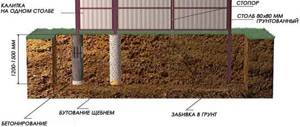
Butting, or how to dig fence posts
The butting method perfectly solves the problems of installing a fence on clay soils and soils with a wet structure. Crushed stone, broken brick, and fragments of other materials are poured into the hole prepared for the support (10-12 cm larger than the diameter of the support). In this case, the backfill is constantly compacted manually or with a special vibrating tool. Butting is an excellent solution for installing supports in marshy, clayey and swampy areas. When carrying out butting in such areas, reinforced laying of reinforcement is required. The materials perform a drainage function. Maximum compaction of the backfill creates a fairly strong connection between the support and the ground.
How to drive fence posts
Hammering posts is used to build lightweight fences, since structures made using this method are not very stable and reliable. The driving of supports is carried out if there are soils containing few stones with dense marl rocks and is impossible if the following soils are present on the site:
- soil is too soft;
- The rocky layers are too deep.
Small supports (up to 2 m) can be buried in the soil with your own hands using a sledgehammer. For more serious fences, special equipment is used for driving in pillars (piles) - “grandmother”.
Installing fence posts with your own hands
There are three types of fence support installation technologies:
- concreting;
- driving pillars into the ground;
- installation in a strip foundation.
The choice of technology depends on the characteristics of the fence and the type of soil where the posts will be installed.
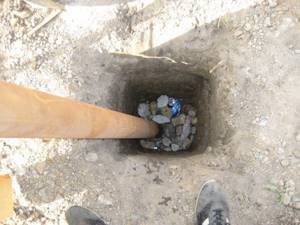
Today, the most popular and universal way to install fence posts is concreting. Its advantages are that it is suitable for metal, wooden, reinforced concrete and asbestos-cement supports, and concreting is easy to do with your own hands.
When concreting fence posts, you should adhere to the following sequence of work:
- prepare a hole of the required diameter in the ground (you can dig it manually or drill it with a garden auger; before drilling, you can pour water into the hole, the soil will become more pliable and the work will go faster);
- install the column and level it;
- fill the space between the edges of the pit and the column with concrete.
For the reliability of the structure, the depth of the hole should be one third of the height of the post; if you dig a hole of less depth, the stability of the fence will be significantly reduced.
Sometimes, a sand-crushed stone cushion (a mixture of sand and fine crushed stone) is poured into the free space of the pit. This increases the stability of the structure if the pillars are installed in highly heaving soil. When filling a hole with a pillow, keep in mind that its height should be ten to fifteen centimeters below the edge of the hole. The free space is filled with concrete.
In the case of installing small-diameter posts in low-stony soils, it is advisable to choose the method of driving the posts into the ground. Using this technology, it is necessary to install the support strictly at right angles to the surface of the soil and drive it into the soil with precise blows. If you need to drive in pillars up to one and a half meters high, you can use a regular sledgehammer; if the height of the support exceeds 1.5 m, it is more convenient to drive them in using a headstock. After completing each blow, check the verticality of the drive with a level.
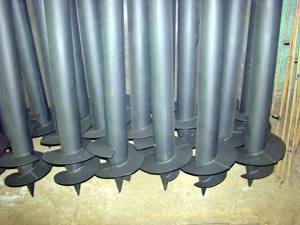
A novelty in the technique of installing fence tables is the installation of screw piles. A screw pile is a metal pipe that has a pointed end and a round screw-type base. When installing such a support, it is necessary to screw it into the ground using pressure, without using any additional devices. When such a support enters the ground, the space between the propeller blades is filled with compacted soil, due to which the pillar receives high stability. Screw piles are used when installing heavy fencing, for example, forged or concrete. The main advantages of screw piles are ease of installation and low cost of pipes.
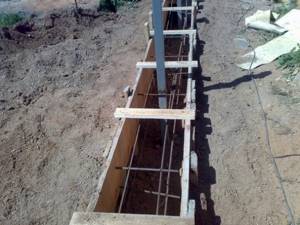
Experts consider installation under a strip foundation to be the most difficult and expensive way to install fence posts, in other words, installing a fence under formwork. This technique for installing supports is used when installing fences made of heavy sections, for example, made of brick or wild stone.
When installing pillars under formwork, you should adhere to the following action plan:
- dig and prepare a trench with a minimum depth of half a meter;
- install metal pipes in the ground around which bricks will be laid;
- lay a sand-crushed stone cushion in order to increase the stability of the structure;
- install formwork around the entire perimeter of the dug trench;
- fill the free space with concrete mixture.
You can lay brick around metal pipes three to four days after pouring the concrete. It is quite difficult for an ordinary person who does not have skills in this matter to carry out the work of installing supports in a strip foundation, so it is better to trust the professionals. It is possible for specialists to only install the posts, and you will mount the fence sections yourself.
Metal fence posts do not like contact with water, especially in the autumn-winter period, so when installing such posts they are usually filled with a solution, after which the upper part of the post is covered with a lid or a wooden plug. The legs are secured with iron brackets, clamps and staples, the thickness of which is 2-3 cm.
For poles made from asbestos-cement pipes, iron brackets are inserted into a pre-prepared hole, then they are filled with concrete.
The staples are made from reinforcement with a diameter of ten to twelve millimeters, thanks to this, if there is a gap of three to four millimeters, you can fit into them freely. These fixtures and clamps are then bolted to the posts.
To install round posts, holes are immediately prepared for them. Such holes are easily drilled in the ground using a hand drill 0.7-0.9 meters deep and filled with crushed stone. Crushed stone can be replaced with broken bricks. The bottom of the pillars is covered with hot bitumen, and the top is secured with a concrete screed.
If it is necessary to hang a gate on the installed posts, they are additionally reinforced with reinforcement - a metal pipe is installed in the center or a metal mesh of two to four rows is made.
You can learn how to easily and simply install fence posts from the video:
